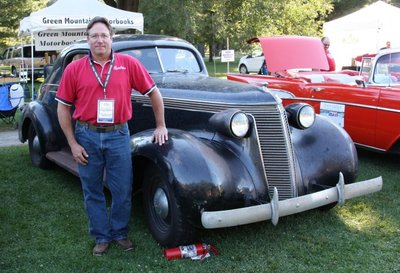As original as it gets: Jon Gray's 1937 Studebaker President rumble seat coupe

Jon Gray with his 1937 Studebaker President. Photos by author.
Some see order where others see chaos, or majesty where others see nothing but disrepair. Jon Gray is one of these glass-is-half-full people, as evidenced by the 1937 Studebaker President he rescued from a 28-year garage slumber in 2012. A true barn find, extracting the Studebaker from its resting place required a chainsaw, a tractor and ample patience to remove the near-three decades of debris cluttered around the car.
Something of a local legend, the Studebaker was the property of a carpenter who’d fallen on hard times. Convincing him to even show the car took some doing, but Jon’s persistence paid off. Heeding the advice of friend John Royals, Jon bought the car not because it was a Studebaker with a rumble seat, but because it was a President, even though doing so required him to sell his 1936 Ford to raise funds.
Though once black, today Jon’s car sports car more oxidation than paint. He doesn’t seem to mind, and went to great lengths so show off the farmyard mud that still coats the inner fenders and parts of the frame. “We drove it to shows for the first year wearing a coat of dust, complete with raccoon prints down the windshield and across the hood,” Jon explained. It’s hard to top that for patina.
The Studebaker has since been cleaned, and Jon admits to vacuuming around five gallons of “mouse detritus” from the rumble seat area. He’s yet to pull the back seat out of the car, but is confident that more rodent residences will be uncovered when he does. The can of wax that Jon found stored on a shelf in the rumble seat compartment is still there, since as he explained, “it was a part of the car when we bought it.”
He confesses to driving the car home on its existing set of tires, but soon replaced them since the flat spots made the car shake badly. He’s changed a fan belt (with an original Studebaker replacement part), replaced a set of points, sleeved the wheel cylinders and the master cylinder, cleaned the carburetor and replaced the exhaust system, but that’s the extent of the mechanical refurbishing the Studebaker has seen. Jon even claims the spark plugs and wires are original, though we’ll bet that both have been replaced at some point during the car’s 77-year lifespan.
The 250.4-cu.in., 115-horsepower L-head inline-eight engine still runs like a top, despite the car’s age and its 73,407 accumulated miles. The three-speed transmission lacks a Synchromesh first gear, and Jon’s Studebaker didn’t come equipped with overdrive, but neither item dims his enthusiasm for the car. “It’s from the Art Deco period,” Jon said, “and it features a Helen Dryden interior.”
Though industrial designer Helen Dryden was an influential figure in both the art and design worlds, she still had to answer to then-Studebaker-design-consultant Raymond Loewy. Nonetheless, Dryden got top billing for the interior of both the Studebaker Dictator and the Studebaker President, which the company proclaimed in period advertising as “styled by Helen Dryden.” Once described by The New York Times as, “the highest paid woman artist in the United States,” Dryden reportedly spent her later years living in a $10 per week welfare-subsidized hotel room, and today is largely unknown outside of art and design circles.
I asked Jon if he had any future plans for the Studebaker that survived the scrap drives of the Second World War, and he shook his head. “We just want to drive it and have fun,” he said, “People really appreciate the way it is and love to see it.”
Judging from the attention it drew at last Saturday’s Cruise-In Spectacular, we’re inclined to agree with him.

